1. Introduction
 After the release of the DVDR1640P burner, Philips moves forward to a higher
Double Layer writing speed. The new DVDR1648P offers 8X DVD+R DL writing speed.
In addition, the drive will burn DVD-R DL media at 4X. The most important feature
of this drive is the SolidBurn Technology, which determines the optimal writing
strategy on DVD media, which is comparable to if not the same as, the one we
met with the BenQ DW1640 drive.
After the release of the DVDR1640P burner, Philips moves forward to a higher
Double Layer writing speed. The new DVDR1648P offers 8X DVD+R DL writing speed.
In addition, the drive will burn DVD-R DL media at 4X. The most important feature
of this drive is the SolidBurn Technology, which determines the optimal writing
strategy on DVD media, which is comparable to if not the same as, the one we
met with the BenQ DW1640 drive.

What is Solidburn?
Philips introduces SolidBurn, a new self-learning feature that will ensure
optimal writing conditions for any recordable DVD+R or DVD-R media. This advanced
writer feature executes a series of tests on an ‘unknown’ DVD media
to determine the optimal writing strategy. Without SolidBurn, new DVD media
and media that are not in the drive's media list, are written using a
less optimal standard write strategy. This could result in lower recording
speeds than specified or lower quality recordings, jeopardizing disc playability
or lifetime.
How does it work?
Before the disc is burned, the drive writes two very short tracks, one in the
LeadIn and one in the LeadOut area of the disc. Then the drive measures the
jitter on both areas and decides if this jitter value is OK or not. If not,
the drive will choose another writing strategy and redo the test until the
Jitter is acceptable. After this, the drive writes your data on the disc,
with the best possible writing strategy, which was found by SolidBurn.
Why SolidBurn?
Every disc sold has unique parameters. Mostly, these parameters are almost
identical, but sometimes, there are better or less than good or even bad discs.
Normal drives will always use the same writing strategy, no matter if the
disc inserted is a good or not so good one. SolidBurn will adapt its writing
strategy for each disc. Normal drives that encounter a disc they do not know,
will use a default writing strategy, which is mostly not the best one. To
guarantee better performance on unknown discs, regular firmware upgrades
are required. SolidBurn makes no difference between known and unknown discs
and will always choose the best writing strategy for each disc.
Solidburn shows the lowest jitter measured (lower is better):

Using SolidBurn also gives the highest possible writing speeds, resulting in the lowest average
recording times:

 Seamless
Link was initially introduced by Acer CM (now BenQ). This technology allows
a CD-RW/DVD+RW drive to automatically monitor the recording status to prevent
buffer under run from occurring.
Seamless
Link was initially introduced by Acer CM (now BenQ). This technology allows
a CD-RW/DVD+RW drive to automatically monitor the recording status to prevent
buffer under run from occurring.
Seamless Link allows the CD-RW drive to store the RecEnd address, the point
in the data to which the recording mechanism has progressed and pause the recording
before a buffer under run occurs. When the buffer is again full, a Seamless
Link-enabled drive locates the RecEnd address and resumes the recording process.
The gap between the stop and restart point is closed, while managing the recording
process precisely and transparently-eliminating under run errors while maintaining
recording accuracy.
Dynamic Calibration
To ensure optimal writing quality over the entire disc at higher writing speeds,
Philips has introduced the Walking OPC algorithm. WOPC directly measures and
optimizes the actual writing quality during the writing process.
At certain intervals, the writing process will be briefly interrupted, the
writing quality directly evaluated and the writing power adjusted accordingly,
if required. The Philips DVD+R/RW writers use a more dynamic implementation
based on the position on the disc and temperature inside the drive. The graph
below shows the writing graph of the drive on a Philips 16X and an 8X DVD+R
disc.


In addition, Philips Dynamic Calibration includes a tilt calibration feature.
The best reading and writing quality can be obtained if the angle between the
disc and the laser beam is 90 degrees. However, if the disc is warped, the
laser beam will no longer be correctly positioned which will cause a distortion
of the laser spot resulting in decreased writing quality if it is not corrected.
The tilt calibration will reposition the Optical Pickup Unit (OPU) to maintain
a 90-degree angle between the laser beam and the disc surface at all times
ensuring an optimal spot shape, even on warped discs. The frequency of the
tilt calibration depends only on the position on the disc according to a non-linear
function. Near the end of the disc, the risk of warping is higher so the frequency
of the tilt calibration will increase accordingly. As with WOPC, the writing
process will be briefly interrupted, the tilt measured and the OPU repositioned
if required.
Walking OPC and Tilt Calibration together form the Dynamic Calibration. Although
they act independently of each other, some effort is taken to synchronize the
Tilt Calibrations with the disc position dependent component of Walking OPC.
Air Flow Cooling System (AFCS), similar to that on the BenQ DW1640, is also
a feature of the Philips DVDR1648P. AFCS helps air circulation inside the drive
and speeds up heat dissipation through the drive's steel housing. The same
applies for Anti-Dust Cooling System (ADCS). With an integrated heat chimney
design, ADCS redirects the heat flow out of the drive, while still providing
protection from dust.
 |
 |
| AFCS |
ADCS |

- Specifications
Interface: |
E-IDE/ATAPI (Ultra DMA Mode 2) |
Writing Speed:
|
DVD+R: 16X, DVD-R: 16X, DVD+RW: 8X, DVD-RW: 6X, DVD+R DL: 8X, DVD-R DL: 4X |
CD-R: 48X, CD-RW: 32X |
Read Speed:
|
DVD+R/-R/+RW/-RW: 10X max |
DVD-ROM: 16X, CD-R/RW: 48X |
Random Access: |
DVD: <150msec, CD: <100msec |
Buffer Size: |
2MB |
|
|
8cm discs, CD-Audio, CD-Bridge, Stereo out (2 cinch), CD-I, CD-Recordable, CD-Rewritable, CD-ROM, CD-Text, DVD+R, DVD+RW, DVD-ROM, DVD/R, DVD/RW, Photo CD
|
Supported Writing Types:
|
Disc at once (DAO), Fixed packet, Multi session (MS), Over-burn writing, Packet writing, Raw mode burning, Session at once (SAO), Track at once (TAO), Variable packet |
| Recording format : |
UDF and ISO 9660 |
Connectivity |
Other connections : 12 V DC in, Analogue audio left / right out 2x, Master / slave select jumper, IDE interface connector |
System Requirements : |
Hard disc space : 500MB
PC OS : Windows 98 SE, 2000, ME, XP
Processor : Pentium III 500MHz or faster
RAM memory : 128 MB |
Dimensions : |
20x15x4 cm (WxDxH) inch |
| Weight : |
0.95 kg |
Technical specifications : |
Humidity : 5 - 90 %RH (no condensation)
Operating temperature range : 5 - 50 °C
Safety standards : EN60950, EN60825,UL1950
EMC standards : EN55022, EMS55024,FCC Part 15 |
- Specifications
The drive does not support Mount Rainier and it uses the well known RPC II
region control, allowing a user to change the drive's region at most 5 times.
Below are the drive's main specs as given by NeroInfoTool and DVDInfoPro::



The drive's front panel is similar to all previous Philips DVD burners. The
only difference is the activity led which is now much smaller than in previous
models. The activity led lights up green when a disc is present and blinks
green when reading, accessing or burning.

On the rear panel you can see the analogue and digital outputs (SPDIF), the
IDE connector and the power input.

Removing the screws and opening the drive's cover voids the drive's warranty.
For reference reasons, we post the following pictures. You can click on the
mainboard picture for a higher resolution image:

The heart of the drive is the new Nexperia PNX7860E chipset from Philips,
the same one we saw in the BenQ DW1640.



- Installation
The drive was installed as secondary master and under WindowsXP was recognized
as "PHILIPS DVDRW1648P1". The drive arrived with firmware
revision P2.2, which we used for our tests.
Below is a screenshot of Nero Burning Rom's specs for the drive.

In this review, we will be comparing the drive with the Pioneer DVR-110 and NEC ND-3540A.
- Testing software
In order to perform our tests we used:
- Nero CD-DVD Speed v4.04
- CDVD Benchmark v1.21
- ExactAudioCopy v0.9 beta5
- Nero Info Tool
- PlexTools v2.25
- DVDInfoPro v4.30
- Nero Burning Rom v6.6.0.17S
2. Reading Tests
- CD Format
The Philips drive supports up to 48X reading speed for CD media, and 40X for rewritable.



The Philips DVDR1648P has very good reading speeds, confirmed by CDSpeed and it seems to be the fastest among the three drives.
- DVD Format

The speed reported by all three burners showed no significant differences between the drives with the Philips DVDR1648P reporting the highest speeds.

The two layers of a PTP DVD-ROM disc are read sequentially
with the drive starting reading from the inner part of the disc, which is the
beginning of each layer, progressing towards the outer range for each layer.
Not a lot between the drives but this time, the Pioneer drive has the highest
reading speeds.

The first layer of an OTP dual layer DVD-ROM is read exactly
the same way as the first layer of the PTP disc we tested previously. The difference
here is the reading strategy of the second layer on the disc. The beginning
of the second layer is located in the outer part of the disc, so the drive
starts reading from the outer tracks towards the inner part of the disc. As
with the PTP DL disc, the Pioneer drive is slightly faster than the Philips
and NEC drives.
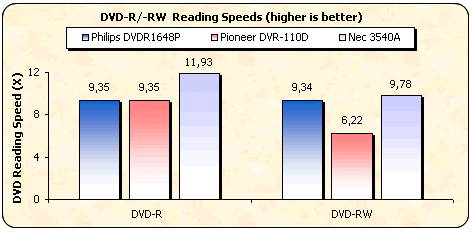

In this reading test, the NEC drive proves fastest, especially with -/+R media.
The Philips DVDR1648P offers consistent reading speeds with all four media.

Although the Pioneer drive reported the highest ripping speed, Philips is also very
fast with DVD-Video DL discs while the NEC drive offered average performance.
-Appendix
Nero CD-DVD Speed Graphs
3. CD Error Correction
In the following tests we check the drive's behavior when reading
scratched / defective audio discs. The test discs used were the ABEX series
from ALMEDIO.
- ABEX TCD-721R


|
Errors
total
|
Num:
837969 |
|
Errors
(Loudness) dB(A)
|
Num: 46634 |
Avg:
-74.0 dB(A) |
Max:
-22.6 dB(A) |
|
Error
Muting Samples
|
Num: 2727 |
Avg:
1.4 Samples |
Max: 537 Samples |
|
Skips
Samples
|
Num: 0 |
Avg:
0 Samples |
Max:
0 Samples |
| Total Test Result |
76.7 points (out of 100.0 maximum) |
Good performance from the Philips DVDR1648P burner. The total error count
is rather low while most importantly, no samples were skipped. From the graph
we can see that the drive has a good CD error correction mechanism, with the
error loudness level being lower than -34.0 dB(A) except for a couple of
spikes which hit a maximum of -22.6 dB(A).
- ABEX TCD-726


|
Errors total
|
Num:
0 |
|
Errors (Loudness) dB(A)
|
Num: 0 |
Avg:
-174.0 dB(A) |
Max: -174.0 dB(A) |
|
Error Muting Samples
|
Num: 0 |
Avg:
0 Samples |
Max:
0 Samples |
|
Skips Samples
|
Num: 0 |
Avg:
0 Samples |
Max: 0 Samples |
| Total Test Result |
100.0 points (out of 100.0 maximum) |
The ABEX TCD-726 test disc is always easier to read and the Philips DVDR1648P
had no problems at all reading it successfully, without a single error reported.
No skipped samples and no error muting samples indicate excellent performance.
This makes the burner a very good reader for defective CD media, in terms of
speed and readability.
- CD-Check Audio Test Disc
 The CD-Check Test Disc is a very useful tool for evaluating the Sound Reproduction
/ Error correction capabilities of a CD player. The disc offers a signal combination
with disc error patterns to rate the drive's abilities to read music and reproduce
it completely. Five tracks on the disc contain a sequence of progressively
more difficult tests. These tracks are referred to as Check Level-1 through
Check Level-5.
The CD-Check Test Disc is a very useful tool for evaluating the Sound Reproduction
/ Error correction capabilities of a CD player. The disc offers a signal combination
with disc error patterns to rate the drive's abilities to read music and reproduce
it completely. Five tracks on the disc contain a sequence of progressively
more difficult tests. These tracks are referred to as Check Level-1 through
Check Level-5.
The
tracks are reproduced through a software multimedia player (i.e.
Windows Media Player). Each level is considered as passed, if the tone
is smooth, continuous without interruptions, skipping or looping. The higher
the Check Level passed, the more reliable the sound reproduction
of the tested drive.
|
Error Level
|
1
|
2
|
3
|
4
|
5
|
| Philips DVDR1648P |
5/5
|
5/5
|
5/5
|
5/5
|
4/5
|
This disc is a very good test to determine a drive's CD error correction.
The fifth track is almost impossible to read with the majority of drives while
most fail even when reading the fourth track. In our case, the Philips drive
impressed us, reading all tracks and reporting a single audible click over the
fifth track and this, in just one out of the five repetitions.
- Summary
The overall performance of the burner with defective and problematic CD media
is very good. One of the best drives in this series of tests in comparison
to the latest drives, and not only.
4. DVD Error Correction Tests
In the following tests we examined the DVD reading capabilities of the Philips DVDR1648P burner with scratched / defective DVD media. For the tests, we used CDVD Benchmark and Nero CDSpeed. The reference test media comes from ALMEDIO.
- Single Layer media
ABEX TDR-821
This is a single sided, single layer DVD-ROM with a 4.7GB capacity, and its surface has an artificial scratch of dimensions varying from 0.4 to 3.0 mm.

The following transfer rate picture comes from the CDVD Benchmark v1.21 transfer rate test.

Very good performance. Some minor speed deviations at the end
of the disc can be considered as unimportant, and they no way present any
problems for the drive. No errors were reported, even at the maximum reading
speed of 16X.
ABEX TDR-825
This is also a single sided, single layer DVD-ROM of 4.7GB capacity. The data structure of the disc is exactly the same as that of the TDR-821, with the difference that there are no scratches on it but instead, defective areas of dimensions ranging from 0.5 to 1.1 mm.

There are also fingerprints sized between 65 and 75 micrometers.

Once again some speed fluctuations at the end of the disc while
reading speed approaches 16X. No problems however.
- Dual Layer media
ABEX TDR-841
This is an 8.5GB dual layer single sided DVD-ROM disc with artificial scratches of dimensions ranging from 0.4 to 3.0mm, on both layers.

Artificial scratches were simply invisible for the BenQ DW1640. The reading
speed reported by CDVD Benchmark utility was the same as with error-free Double
Layer media. Once again, excellent performance.

Perfect, smooth reading graph. Excellent DVD error correction at 12X with
our DL test disc.
ABEX TDR-845
The disc is a single sided, dual layer DVD-ROM disc of a capacity of 8.5GB. The only difference between the TDR-845 and the TDR-841 is that the first includes defective areas and fingerprints.

The dimensions of the defective areas range from 0.5 to 1.1 mm and the fingerprints are sized from 65 to 75 micro meters.

Flawless reading. No errors or speed drops of any kind over
the defective areas.
ABEX TDV-541
The TDV-541 is a single sided, dual layer DVD-VIDEO disc, with a capacity
of 8.5GB. The disc is based on the TDV-540 series which is designed for inspection
and adjustment of DVD-VIDEO players. The disc checks the layer switch operation
from layer 0 to layer 1 and also includes test pictures and test signals for
DVD sound files.

The current TDV-541 also checks the error correcting capabilities of
the drive and includes scratches from 0.4 to 3.0 mm.

This disc was not a problem for the Philips drive. Excellent DVD error correction
capabilities.
ABEX TDV-545
The TDV-545 disc is based on the TDV-540 series. It is a single sided, dual layer DVD-VIDEO disc with a capacity of 8.5GB. The TDV-545 includes artificial black dots on the data surface, sized from 0.4 to 1.0 mm. It has also 65 - 75 micro meter fingerprints.


As smooth a reading graph as you can get, indicating once again strong DVD error
correction.
- Summary
The Philips drive is definitely a very good DVD reader. Most common scratches
are not a problem for the drive while even the larger defects could not shake
its solid performance. There's nothing more you can expect from a drive.
5. Protected Disc Tests
- Reading Tests
To create the image of the various protected titles to the hard disk, we used Alcohol 120% software and the appropriate settings, according to the protection type of the inserted discs. Below you can see the duration of each process as well as the transfer rate in each case.
| Game Title |
Protection Scheme |
Duration |
Reading speed |
| PSX "NBA Jam Extreme" |
Lybcrypt |
00:50 min |
1807 sectors/sec |
| Serious Sam The Second Encounter v1.07 |
SafeDisc v.2.60.052 |
1:33:44 min |
104 sectors/sec |
| VRally II |
SecuROM v.2 |
2:26 min |
2355 sectors/sec |



The Philips drive will rip fast any PSX game and even faster, any SecuROM
protected disc. With Safedisc protection however, the reported reading speed
was rather slow and the whole process lasted 1:33:44 mins.
- Writing Tests
The Philips DVDR1648P supports the DAO-RAW writing mode. For checking the drive's
EFM correction status, we used 5 different game titles with different SafeDisc
2 versions having the latest software patches installed. After making the images
of the various titles onto the hard disk, we burned them (maximum speed) with
Alcohol 120% v1.9.2.1705. Two different discs were created for each title;
one with the "Rectify Sub-Channel Data" enabled and one more with the function
disabled.
- FIFA 2004 - Safe Disc v3.1x
- The Sims Superstar - Safe Disc v2.9x
- The Sims Unleashed - Safe Disc v2.8x
- Serious Sam Second Encounter - Safe Disc v2.51.021
- Max Payne - Safe Disc v2.51.020
The drive is capable of creating working backups only up to SD v2.8, which
is typical performance with most drives. Moreover, all discs we burned produced
the following message with the DVDR1648P. With other, different drives, there
was no problem.

6. DAE Tests
- Pressed and CDR Audio CD results
The Philips DVDRW1648P supports up to 48X CAV DAE speed, which is the fastest
available speed on the market today. The following results were reported when
using Exact Audio Copy software.

As seen in the graph above, the superiority of the Philips drive is significant.
Note that the Pioneer and NEC drives support up to 40x CAV DAE.

The Philips drive does not report C2 errors, according to EAC.
- Advanced DAE Quality

Once again the Philips drive reached a maximum of 48X DAE speed, and as was
expected, its average reported speed was higher than the Pioneer and NEC drives.
Not only is it fast, but the drive also managed to obtain a perfect quality
score of 100.

The drive can read Leadin data, CD Text and Subchannel Data, but it cannot
read Leadout data.
- Ripping 90mins Audio CDs

As with most of the latest drives, the Philips failed to read/rip our 90min
test disc, despite all its efforts and even reducing speed.
- Ripping 99mins Audio CDs

Our 99min test disc was not a problem for the Philips DVDR1648P drive.
7. Audio Protections Tests
For the test procedure we used three audio discs with different audio copy
protections. The ripping process on all protected Audio discs was carried out
with Exact Audio Copy v0.9 beta5. The tested protected Audio discs were:
| Audio Discs |
Protection |
| Celine Dion - New Day Has Come |
Sony's Key2Audio |
| Natalie Imbruglia - White Lilies Island |
Cactus Data Shield 200 |
| Aiko Katsukino - The Love Letter |
Cactus Data Shield 200.0.4 - 3.0 build 16a |
The Cactus Data Shield 200 contains artificial errors that are not easily
bypassed by the reader, while the Key2Audio contains a second session causing
problems for readers when trying to read the Table Of Contents (TOC).
The Philips DVDR1648 recorder recognized up to the 12th Audio track of the
CDS200 disc,

and with the "Retrieve Native TOC" option removed, the 13th Data track
was also recognized.

The test results are shown in the following table:
| Philips 1648 |
Key2Audio |
CDS200 |
| Ripping process completed, EAC reports no problems, Read&Test CRC comparison successful for all tracks |
Ripping process completed, EAC reports no problems, Read&Test CRC comparison successful for all tracks |
With the Key2Audio discs and CDS200, EAC did not report any timing problems
and at the same time, Read&Test CRC check comparison was the same for corresponding
tracks.
- Cactus Data Shield 200.0.4 - 3.0 build 16a (Aiko Katsukino - The Love Letter)
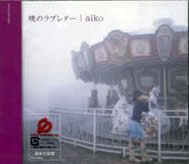 This
is a "special" CDS200 build, since it doesn't contain any artificial errors during the ripping process. Most problems occur when trying to write the ripped wav files, since the produced CD-R disc contains C2 and CU errors! This "problem" is
rumored to be connected with specific chipset weaknesses.We ripped the disc
contents with EAC and burned the wav file produced from the Cactus Data Shield
200.0.4
- 3.0 build 16a disc with the latest Nero version as AudioCD+CD-Text. The burned
media was checked for C1/C2 errors and for BETA/Jitter errors with PlexTools
software using Plextor PX-716A.
This
is a "special" CDS200 build, since it doesn't contain any artificial errors during the ripping process. Most problems occur when trying to write the ripped wav files, since the produced CD-R disc contains C2 and CU errors! This "problem" is
rumored to be connected with specific chipset weaknesses.We ripped the disc
contents with EAC and burned the wav file produced from the Cactus Data Shield
200.0.4
- 3.0 build 16a disc with the latest Nero version as AudioCD+CD-Text. The burned
media was checked for C1/C2 errors and for BETA/Jitter errors with PlexTools
software using Plextor PX-716A.
| Philips 1648 |
CDS 200.0.4 - 3.0 build 16a |
| Reading performed without any errors. |
- C1C2 Error rate from PleXWriter PX-716A (8X CLV reading speed)

- BETA/Jitter Error rate from PleXWriter PX-716A
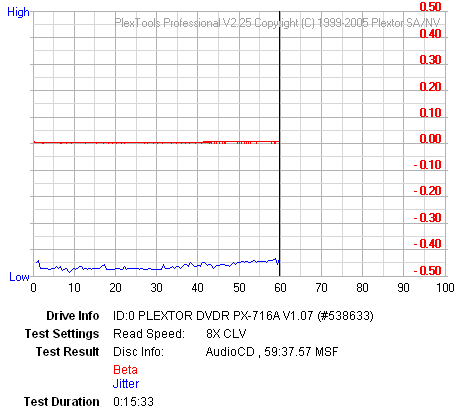
The C1/C2 error graphs show that the Philips 1648 drive managed to produce
a 100% error free disc.
We then tried to extract all wav files with the Plextor PX-716A and PlexTools
DAE Error Correction 5th Level enabled:

No errors were reported after extracting all files. The drive can backup the
disc 100% accurately.
8. CD Recording Tests
- CD-R Format
The drive supports 8X, 16X, 24X, 32X, 40X and 48X (CAV) writing speeds.

According to Nero CDSpeed, the drive managed to burn a full 700MB CD at
48X in 2:51min. The reported average speed was 36.31X while the process started
at 21.29X and finished at 47.98X.
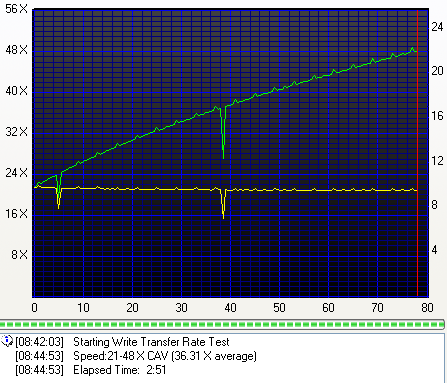
- CD-R Recording Times
We created an 80min data compilation with Nero Burning Rom and recorded
it on a 700MB disc. The writing performance varies according to the inserted
media. Below is a chart depicting all recording times with
various media.

Most media were recorded at 48x, but there were some exceptions, like the
RiDisc and Intenso media that were recorded at 40X. Best performance came
with Verbatim 52x media.

The Philips DVDRW1648P proved to be faster (48X recording) than the NEC ND-3540A while the Pioneer drive was slowest, having a maximum writing speed of 40X.
- Other features
| Overburning writing |
Up to 99min |
| CD text reading/writing |
Yes |

- CD-RW Format
The Philips burner supports 4x, 10x, 16x, 24x and 32x rewriting speeds,
with Ultra Speed Rewritable Media
(US-RW).
Below you can see the Nero CD Speed writing simulation test with blank 32x
US-RW media from Mitsubishi Chemicals. The recording task started at 21.32X
and finished at 32.63X having an average speed of 30.49X. The task lasted 3:00min.

- CD-RW Mount Rainier
The Philips drive does not support the Mount Rainier feature.
9. C1/C2 Errors Measurements
We measured the C1 / C2 error rate on the recorded discs we burned at the
various supported writing speeds. The software we used is the latest PleXTools Professional
and in particular the built-in Q-Check utility. The reader
was the Plextor PX-716A.
- BenQ 80min 52X @ 48X

- Intenso 80min 52X @ 40X

- MMore 80min 52X @ 48X

- SKC 80min 52X @ 48X

- Traxdata 80min 40X @ 48X

- TY 80min 48X @ 48X

| Brand |
ID Code |
Manufacturer Name |
Lead Out TIme |
Burned Speed |
| MMore 80min 52X |
97m17s 06f |
Moser Baer India Ltd |
79m59s74f |
48X |
| Intenso 80min 52X |
97m32s19f |
Prodisc Technology Inc. |
79m59s72f |
40X |
| SKC 80min 52X |
97m26s 26f |
SKC Co Ltd |
79m59s73f |
48X |
| Taiyo Yuden 80min 48X |
97m24s01f |
Taiyo Yuden Company Limited |
79m59s72f |
48X |
| TraxData 80min 40X |
97m15s17f |
Ritek Co. |
79m59s70f |
48X |
| BenQ 52X |
97m22s67f |
Daxon |
79m59s74f |
48X |
- Summary
All burned CDs reported good quality as can be seen in the above graph. With
the exception of the Intenso disc, where some C2 errors were reported, we can
safely say that the Philips 1648 is a quality CD burner. For further investigation
of the CD burning quality of this drive, we will put the burned media under
the scope using the CDX quality checker.
10. Writing Quality - Clover System Tests
The Clover Systems CDX Compact Disc Analyzer is a high-speed tool to quantitatively measure the quality of a CD. It will analyze CD-DA, CD-ROM, CD-ROM XA, CD-I, CD-R, Photo-CD, Enhanced CD and CD-RW discs at 4X, 8X, 24X, 32X or 40X speed. It effectively measures disc quality by examining the quantity and severity of CIRC errors generated during playback. It also provides the capability to measure signal parameters related to pit geometry, such as asymmetry and reflectivity. Together, all these bits of information provide a thorough analysis of disc quality. The Clover Systems Analyzers can also perform various format-checking tests on data discs, and do bit-for-bit data comparison on all types of CDs. All tests are carried out at the maximum speed of 40X.
CIRC error correction uses two principles to detect and correct errors. The first is redundancy (extra information is added, which gives an extra chance to read the disc), and the second is interleaving (data is distributed over a relatively large physical area). The CIRC error correction used in CD players uses two stages of error correction, the well known C1 and C2, with de-interleaving of the data between the stages.
The error type E11 means one bad symbol was corrected in the C1 stage. E21means two bad symbols were corrected in the C1 stage. E31 means that there were three or more bad symbols at the C1 stage. This block is uncorrectable at the C1 stage, and is passed to the C2 stage. Respectively, E12 means one bad symbol was corrected in the C2 stage and E22 means two bad symbols were corrected in the C2 stage. E32 means that there were three or more bad symbols in one block at the C2 stage, and therefore this error is not correctable.
BLER (Block Error Rate) is defined as the number of data blocks per second that contain detectable errors, at the input of the C1 decoder. Since this is the most general measurement of the quality of a disc, you will find BLER graphs for all media tested below. If you click on the images you can see a more detailed table, indicating error levels. The Red Book specification (IEC 908) calls for a maximum BLER of 220 per second averaged over ten seconds. Discs with higher BLER are likely to produce uncorrectable errors. Al low BLER shows that the system as a whole is performing well, and the pit geometry is good. However, BLER only tells us how many errors were generated per second, and it does not tell us anything about the severity of those errors.
- BenQ 80min 52X @ 48X

- Intenso 80min 52X @ 40X

- MMore 80min 52X @ 48X

- SKC 80min 52X @ 48X

- Traxdata 80min 40X @ 48X

- TY 80min 48X @ 48X

The following table gives us a detailed summary of the scanned
media...

- Summary
Most of the media reported good quality although the grade indication (pass/fail)
from Clover System failed all but one. As we have mentioned on previous occasions,
this is a very strict test and not many burner/media combinations pass.
11. DVD Recording Tests
- Writing Performance
The Philips DVDR1648P supports up to 16X burning speed with both +R and -R DVD media formats. For our tests Philips provided us with a Nero version which was modified for the specific drive, the 6.6.0.17b, in order to be compatible with Philips' SolidBurn Technology. The same package also included CDSpeed v.4.06.
By using Nero CD-DVD Speed with DVD-R and DVD+R media, we are able to see
the 16X CAV recording technology in action for -R
and +R media. You can clearly see that WOPC is activated.

This is what we got when we ran the simulation test in Nero CDSpeed.

However, this seems not to be correct, so we decided to use the Create Data
Disc function of CDSpeed. This is what we got:

- Burning Tests
SolidBurn

The drive's most important feature, which differentiates it from the competition,
is its support of the SolidBurn Technology.
Let's start with the Overspeed function. Enabling the Overspeed function will
automatically enable the SolidBurn feature for both "known" and unknown" media.
The known media are those that have been included in the drive's memory, which
would mean that the drive already knows the optimum writing strategy for the
specific disc. Unknown media are those discs that are burned by the drive for
the first time. Our first attempt to burn our media was done with following
selection:

Despite the Overspeed function, none of the discs were burned at a higher
speed than that at which they are certified.
For the tests, we tried to burn more than 50 different DVD media. Among them,
we deduced that the drive had problems with the discs
indicated in red in the
following tables. the Philips DVDR1648P gave an error message during the lead
in area on those discs:

Despite the recording error, the discs were not burned, so that they could
be used again. The rest of the media were successfully burned with the Overspeed/SolidBurn
functions enabled, as you can see in the tables.
The next step was to disable the "Overspeed burning" feature and
enable the SolidBurn feature. However, nothing changed and the drive failed
at the lead in again with specific media (in red).

Finally, we tried with SolidBurn disabled. To be honest, we didn't notice
any great difference. After several attempts of starting/closing Nero and enabling/disabling
SolidBurn, we managed to burn the discs. This behavior however, leaves us with
some questions about the compatibility of the Nero software with SolidBurn,
or even the implementation of the function on the drive itself.

Since the QSuite from BenQ is compatible with the Philips DVDR1648P drive,
we decided to try it in combination with a previous Nero version, 6.6.0.16,
which was not compatible with SolidBurn. Still the same behavior. Especially
in the case of Ridisc 8X DVD-R (MCC02RG20), we never managed to make a burn.
For our tests, we used several DVD+R/RW and DVD-R/RW for different manufacturers.
The media ID, recording speed and writing time needed for each disc can be
found in the following tables.

We burned the RW media with SolidBurn enabled and disabled. For Ricoh media,
the time needed with SolidBurn enabled was 8:44 min. With
the feature disabled, the recording time was 8:26 min. For
the Mitsubishi Chemicals disc, the times
were 8:44 min and 7:41 min respectively

Once again we tried with RW media with the SolidBurn feature enabled and disabled.
With the Traxdata disc, the Philips drive needed 10:18 min with
SolidBurn enabled while 10:04 min with the feature disabled.
The respective times for the Mitsubishi
Chemicals disc were10:14 min and 10:09 min.
The reported times are quite good from the Philips DVDR1648P.
SolidBurn Example
The reported writing time needed for the Philips drive to burn a Mitsubishi
Chemicals 16X DVD+R, according to the table above (6:23 min), uncovers a recording
speed lower than 16X. For this reason, we used the CDSpeed "Create Data
Disc" test, in order to find out what actually happened.

Although the drive recognized the disc as a 16X and Nero reported a successful
burning at 16X, the actual writing strategy was set for 12X.
Once again, with the contribution from QSuite, we found that the drive had stored
the specific writing strategy for this medium in its memory. After cleaning the drive's EEPROM,
the disc was burned at 16X.
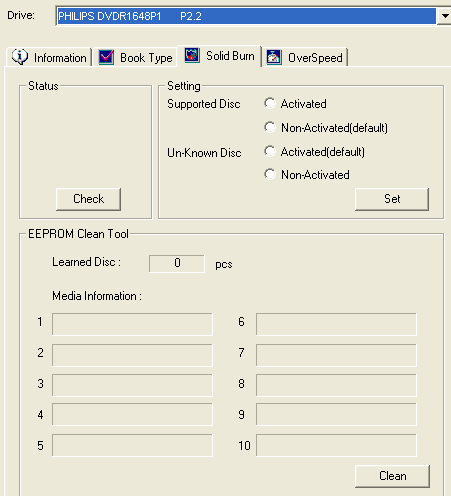
- Comparison with other drives


Good writing times from the Philips DVDR1648P, which required the lowest time
to burn a DVD+R disc, in comparison to the Pioneer and NEC burners.
- DVD Overburning Tests
According to CDSpeed, the drive supports overburning for both DVD+R and DVD-R
formats.


Although according to CDSpeed the drive is capable of DVD overburning, we tried to burn a 4530MB compilation with Nero Burning Rom and a DVD+R disc from Taiyo Yuden but it failed.
- DVD+MRW Tests
The Philips DVDR1648P does not support the Mount
Rainier feature.
12. CDSpeed/PlexTools Scans - Page 1
In order to test the writing quality and readability of the burned media we
used two readers with two software applications:
- The LiteON SOHD-167T with patched firmware being able to read DVD5 up to
16X CAV and DVD9 up to 10X CAV. For the transfer rate tests we used
the
latest Nero CDSpeed version.
- The Plextor PX-716A with the latest available firmware. For scanning the
disc, we used the latest PlexTools version at 2X CLV reading speed,
BURST mode, with middle accuracy.
In general, a "perfect" disc should have a smooth reading curve,
very low PIE/POE and zero (0) POF error rates. Most times however, even though
a disc has very low PIE/POE error rates, the reading curve may not be smooth
containing
dropoffs.
Due to the fact that we oversped the reading capabilities of the LiteON SOHD-167T,
such drops are expected, especially near the outer area of the disc.
The measurements below should be taken not as the absolute criteria of the
burning quality, but as an indication level.
16X DVD-R Writing Speed
- Verbatim 16X DVD-R @ 16X ( SolidBurn Enabled)


- Verbatim 16X DVD-R @ 16X ( SolidBurn Disabled)


- Traxdata 16 X DVD-R @ 16X ( SolidBurn Disabled)


- BenQ 16X DVD-R @ 16X ( SolidBurn Enabled)


- CMC Magnetics 16 X DVD-R @ 16X ( SolidBurn Disabled)


- Optodisc 16 X DVD-R @ 16X ( SolidBurn Disabled)
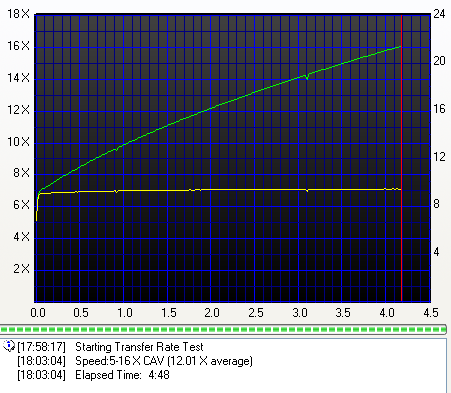

- Prodisc 16X DVD-R @ 16X, ProdiscS05 ( SolidBurn Enabled)


- Prodisc 16X DVD-R @ 16X, ProdiscF02 ( SolidBurn Enabled)


- Summary
Smooth graphs from CD/DVD Speed and no PI errors higher than 100. Nothing
but very good performance. It seems that the Philips DVDR1648P can burn 16X
DVD-R media at high quality.
13. CDSpeed/PlexTools Scans - Page 2
In order to test the writing quality and readability of the burned media we
used two readers with two software applications:
- The LiteON SOHD-167T with patched firmware being able to read DVD5 up to
16X CAV and DVD9 up to 10X CAV. For the transfer rate tests we used the latest
Nero CDSpeed version.
- The Plextor PX-716A with the latest available firmware. For scanning the
disc, we used the latest PlexTools version at 2X CLV reading speed, BURST
mode, with middle accuracy.
In general, a "perfect" disc should have a smooth reading curve,
very low PIE/POE and zero (0) POF error rates. Most times however, even though
a disc has very low PIE/POE error rates, the reading curve may not be smooth
containing dropoffs. Due to the fact that we oversped the reading capabilities
of the LiteON SOHD-167T, such drops are expected, especially near the outer
area of the disc.
The measurements below should be taken not as the absolute criteria of the
burning quality, but as an indication level.
8X DVD-R Writing Speed
- 3A 8X DVD-R @ 8X ( SolidBurn Disabled)


- BenQ 8X DVD-R @ 8X ( SolidBurn Enabled)


- BulkPaq 8X DVD-R @ 8X ( SolidBurn Enabled)


- Datawrite 8X DVD-R @ 8X ( SolidBurn Enabled)
LiteOn 167T with CDSpeed couldn't initialize the disc



- MMore 8X DVD-R @ 8X ( SolidBurn Enabled)


- Optodisc 8X DVD-R @ 8X ( SolidBurn Enabled)


- Ridisc 8X DVD-R @ 8X ( SolidBurn Enabled)


- Taiyo Yuden 8X DVD-R @ 8X ( SolidBurn Enabled)


- TDK 8X DVD-R @ 8X ( SolidBurn Enabled)

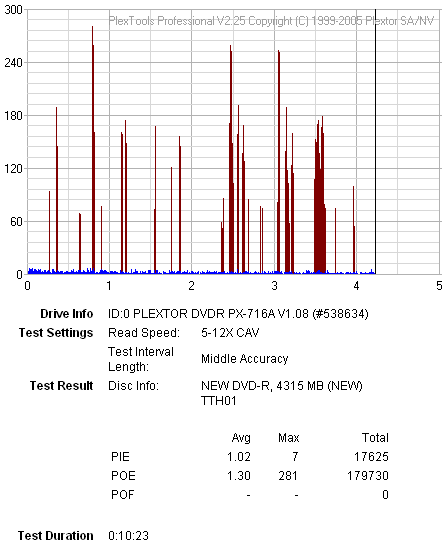
- Prodisc 8X DVD-R @ 8X ( SolidBurn Enabled)
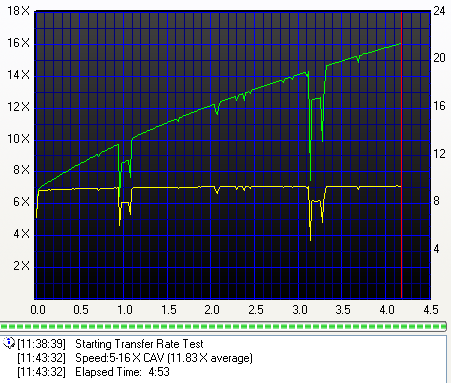

- Summary
Almost all discs reported excellent writing quality. Prodisc media reported
slightly increased PIE errors but they were within the acceptable levels, lower
than 280, while the CDSpeed reading graph was good. In the case of the 3A disc,
the quality is only average but this is a single occasion.
14. CDSpeed/PlexTools Scans - Page 3
In order to test the writing quality and readability of the burned media we
used two readers with two software applications:
- The LiteON SOHD-167T with patched firmware being able to read DVD5 up to
16X CAV and DVD9 up to 10X CAV. For the transfer rate tests we used the latest
Nero CDSpeed version.
- The Plextor PX-716A with the latest available firmware. For scanning the
disc, we used the latest PlexTools version at 2X CLV reading speed, BURST
mode, with middle accuracy.
In general, a "perfect" disc should have a smooth reading curve,
very low PIE/POE and zero (0) POF error rates. Most times however, even though
a disc has very low PIE/POE error rates, the reading curve may not be smooth
containing dropoffs. Due to the fact that we oversped the reading capabilities
of the LiteON SOHD-167T, such drops are expected, especially near the outer
area of the disc.
The measurements below should be taken not as the absolute criteria of the
burning quality, but as an indication level.
16X DVD+R Writing Speed
- CMC Magnetics 16X DVD+R @ 16X ( SolidBurn Disabled)


- BenQ 16X DVD+R @ 16X ( SolidBurn Disabled)


- Optodisc 16X DVD+R @ 16X ( SolidBurn Disabled)


- Philips 16X DVD+R @ 16X ( SolidBurn Enabled)


- Ricoh 16X DVD+R @ 16X ( SolidBurn Disabled)


- RiDisc 16X DVD+R @ 16X ( SolidBurn Disabled)


- MMore 16X DVD+R @ 16X ( SolidBurn Disabled)


- Traxdata 16X DVD+R @ 16X ( SolidBurn Enabled)


- Verbatim 16X DVD+R @ 16X ( SolidBurn Enabled)


- Prodisc 16X DVD+R @ 16X, ProdiscR04 ( SolidBurn Enabled)


- Prodisc 16X DVD+R @ 16X, ProdiscR05 ( SolidBurn Enabled)


- Summary
As we can see, there is a large compatibility list for 16X DVD+R media with
the Philips DVDR1648P. The reported quality, according to our tests above,
is very good. Error levels in Plextools are extremely low while the reading
graphs with CDSpeed, smooth in most cases. With a couple of media, the CDSpeed
readings are not 100% smooth but this is not something that can tarnish the
overall quality.
15. CDSpeed/PlexTools Scans - Page 4
In order to test the writing quality and readability of the burned media we
used two readers with two software applications:
- The LiteON SOHD-167T with patched firmware being able to read DVD5 up to
16X CAV and DVD9 up to 10X CAV. For the transfer rate tests we used the latest
Nero CDSpeed version.
- The Plextor PX-716A with the latest available firmware. For scanning the
disc, we used the latest PlexTools version at 2X CLV reading speed, BURST
mode, with middle accuracy.
In general, a "perfect" disc should have a smooth reading curve,
very low PIE/POE and zero (0) POF error rates. Most times however, even though
a disc has very low PIE/POE error rates, the reading curve may not be smooth
containing dropoffs. Due to the fact that we oversped the reading capabilities
of the LiteON SOHD-167T, such drops are expected, especially near the outer
area of the disc.
The measurements below should be taken not as the absolute criteria of the
burning quality, but as an indication level.
8X DVD+R Writing Speed
- Datawrite 8X DVD+R @ 8X ( SolidBurn Enabled)


- MMore 8X DVD+R @ 8X ( SolidBurn Enabled)


- Mitsubishi Chemicals 8X DVD+R @ 8X ( SolidBurn Enabled)


- CMC Magnetics 8X DVD+R @ 8X ( SolidBurn Enabled)


- BeAll 8X DVD+R @ 8X ( SolidBurn Disabled)


- TDK 8X DVD+R @ 8X ( SolidBurn Enabled)


- Ricoh 8X DVD+R @ 8X ( SolidBurn Enabled)


- Optodisc 8X DVD+R @ 8X ( SolidBurn Enabled)


- TY 8X DVD+R @ 8X ( SolidBurn Enabled)


- Traxdata 8X DVD+R @ 8X ( SolidBurn Enabled)


- BenQ 8X DVD+R @ 8X ( SolidBurn Disabled)


- Maxell 8X DVD+R @ 8X ( SolidBurn Enabled)


- Prodisc 8X DVD+R @ 8X ( SolidBurn Enabled)


- Summary
Very good writing quality at 8X with DVD+R media. Almost all media reported
extremely low error levels while the CDSpeed reading graphs were smooth. This
performance makes the Philips DVDR1648P one of the top recorders on the market.
16. CDSpeed/PlexTools Scans - Page 5
In order to test the writing quality and readability of the burned media we
used two readers with two software applications:
- The LiteON SOHD-167T with patched firmware being able to read DVD5 up to
16X CAV and DVD9 up to 10X CAV. For the transfer rate tests we used the latest
Nero CDSpeed version.
- The Plextor PX-712A with the latest available firmware. For scanning the
disc, we used the latest PlexTools version at 2X CLV reading speed, BURST
mode, with middle accuracy.
In general, a "perfect" disc should have a smooth reading curve,
very low PIE/POE and zero (0) POF error rates. Most times however, even though
a disc has very low PIE/POE error rates, the reading curve may not be smooth
containing dropoffs. Due to the fact that we oversped the reading capabilities
of the LiteON SOHD-167T, such drops are expected, especially near the outer
area of the disc.
The measurements below should be taken not as the absolute criteria of the
burning quality, but as an indication level.
DVD+RW and DVD-RW Media
- MKM 8X DVD+RW @ 8X ( SolidBurn Enabled)


- MKM 8X DVD+RW @ 8X ( SolidBurn Disabled)


- Ricoh 8X DVD+RW @ 8X ( SolidBurn Enabled)


- Ricoh 8X DVD+RW @ 8X ( SolidBurn Disabled)


- MKM 6X DVD-RW @ 6X ( SolidBurn Enabled)


- MKM 6X DVD-RW @ 6X ( SolidBurn Disabled)
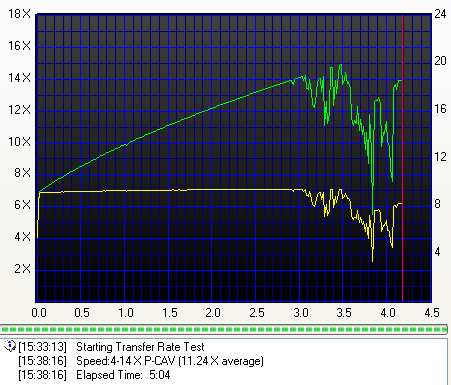
Plextools couldn't access disc.
- Traxdata 6X DVD-RW @ 6X ( SolidBurn Enabled)


- Traxdata 6X DVD-RW @ 6X ( SolidBurn Disabled)

Plextools couldn't access disc.
- Summary
According to our scans, we can safely say that the drive has great writing
quality, even with RW media. The only average to good results were with Ricoh's
media but this doesn't change overall performance. Notice
that although we used all media with SolidBurn enabled and disabled, there
are no actual differences, apart from the fact that the two DVD-RW media with
SolidBurn disabled, failed to initialize with the Plextor drive. However, according
to CDSpeed, their writing quality seems to be great.
17. Writing Quality - Almedio AEC-1000
The AEC-1000 consists of a DVD Drive and the "ALChecker" error measurement application which can check the written data quality. The application is capable of 1X CLV measurement as well as 4X CLV on DVD-Video/ROM and finalized DVD+R/-R media.
There are three measurement modes:
- Fine Mode: checks a series of eight consecutive ECC blocks,
- Rough Mode: checks eight consecutive ECC blocks every 100h ECC blocks
- Quick Mode: checks three specified areas
The checking status is shown graphically in real time while you can save the error graph at the end of the test. The reported errors are the PI and the UncPO. In the case of PI, it counts the number of rows corrected by the PI error correction in each group of eight consecutive ECC blocks. In the case of UncPO, it counts the number of ECC blocks in which more than one byte is uncorrectable in eight consecutive ECC blocks. For our quality scans, we set it for 1X CLV and Fine Mode which is the slowest and with the safest results. Also, we chose to measure all the media burned at the maximum available writing speed, namely 16X.





- Mitsubishi Chemicals 16X DVD+R @ 16X

- Mitsubishi Chemicals 16X DVD-R @ 16X ( SolidBurn Enabled)

- Mitsubishi Chemicals 16X DVD-R @ 16X ( SolidBurn Disabled)

- Summary
In all cases, the writing quality is rather good, with low PI error levels,
except for those with Mitsubishi Chemicals media where the PI error exceeded
the limit of 280. Notice at this point that the SolidBurn feature did not affect
the writing quality, which was almost the same in both cases, i.e. with the
feature enabled and disabled.
18. DVD+R DL - Page 1
- Writing Tests
We burned some DVD+R DL and DVD-R DL discs with data content. For this task
we used "Create Data Disc" from Nero CDSpeed in order to fully burn
the discs.
Mitsubishi Chemicals DVD+R DL 8X

The specific DL disc from Mitsubishi Chemicals is certified for 8X burning,
one of the few if not the only one. Since it is new, most burners don't support
it at 8X, while the Philips seems to. However, the recording speed was reduced
over the second layer from 8X down to 4X. This is the reason for the reported
22:06 min total time needed.
Traxdata DVD+R DL 2.4X

Since our first burned disc was not readable with CDSpeed and Plextools, we
repeated the recording with a second disc. Unfortunately, it seems that the
drive does not like the specific media. During the burning process, we got
the following message.

Mitsubishi Chemicals DVD-R DL 4X

No problems with the specific media from Mitsubishi Chemicals. The reported
recording time at 4X was 29:25 min.
We also tried the new DVD-R DL 4X disc from Traxdata, but it seems that the
Philips drive is not compatible with the specific media, at least with the
current firmware revision.
We hope the next firmware for the Philips DVDR1648P drive will solve any issues
we have encountered with Traxdata media.
19. DVD+R DL - Page 2
- Writing Quality
In order to measure the DVD+R DL and DVD-R DL writing quality of the Philips DVDR1648P burner, we used
the LiteOn SOHD-167T and the Plextor PX-716A drives.




As long as the DL media is compatible with the Philips DVDR1648P, the writing
quality is rather good. The above scans confirm this.
20. Philips DVDR1648P vs SA300 - Page 1
For checking exactly what
the Philips DVDR1648P reports, we used four different media, burned with other
recorders. The three media have been measured with the well known AudioDev
SA300 DVD
CATS system at 1X.
The drive is capable of reporting PI/PIF errors, so we will compare those
measurements at 4X reading speed.
Please note that the posted results are only valid for the specific tested Philips DVDR1648P drive. Using other drives, even another Philips DVDR1648P, can produce totally different
results. Be aware!
#1st Test Disc - PISum8/PIF Comparison - 8X Reading speed


Click on the image for details

As you can easily see in the graphs above, the error line trend follows the
same pattern as the CATS system's scans, but error values are different. Scanning
is supposed to be at 4X but the actual speed was only 0.5X~1X.
21. Philips DVDR1648P vs SA300 - Page 2
For checking exactly what the Philips DVDR1648P reports, we used three different media, burned with other recorders. The three media have been measured with the well known AudioDev SA300 DVD CATS system at 1X.
The drive is capable of reporting PI/PIF errors, so we will compare those measurements at 4X reading speed.
Please note that the posted results are only valid for the specific tested Philips DVDR1648P drive. Using other drives, even another Philips DVDR1648P, can produce totally different results. Be aware!
#2nd Test Disc - PISum8/PIF Comparison - 4X Reading speed


Click on the image for details

The error line trend follows a completely different pattern to the CATS scans.
Once again, the actual speed was rather low, 0.5X~1X.
22. Philips DVDR1648P vs SA300 - Page 3
For checking exactly what the Philips DVDR1648P, we used three different media, burned with other recorders. The three media have been measured with the well known AudioDev SA300 DVD CATS system at 1X.
The drive is capable of reporting PI/PIF errors, so we will compare those measurements at 4X reading speed.
Please note that the posted results are only valid for the specific tested Philips DVDR1648P drive. Using other drives, even another Philips DVDR1648P, can produce totally different results. Be aware!
#2nd Test Disc - PISum8/PIF Comparison - 4X Reading speed


Click on the image for details

Similar scans from the Philips burner and the CATS system. Slow
reading though.
23. Philips DVDR1648P vs SA300 - Page 4
For checking exactly what the Philips DVDR1648P, we used three different
media, burned with other recorders. The three media have been measured
using the well known AudioDev SA300 DVD CATS system at 1X.
The drive is capable of reporting PI/PIF errors, so we will compare those measurements at 4X reading speed.
Please note that the posted results are only valid for the specific tested Philips DVDR1648P drive. Using other drives, even another Philips DVDR1648P, can produce totally different
results. Be aware!
#3rd Test Disc - PISum8/PIF Comparison - 4X Reading speed


Click on the image for details

Similar results for the Philips and the AudioDev SA300. Notice
that the drive is supposed to scan at 4X, but actually the reading speed was
again 0.5X~1X. In our opinion, it is not worth scanning at such a low speed.
It simply takes too long.
24. Booktype Setting
 As expected, like any other Philips drive, the DVDR1648P is capable of changing
the default booktype setting for both Single Layer and Double Layer media.
Using the DVD-ROM booktype setting greatly increases compatibility with other
players and drives. The booktype is set by default to DVD-ROM for all plus
media formats.
As expected, like any other Philips drive, the DVDR1648P is capable of changing
the default booktype setting for both Single Layer and Double Layer media.
Using the DVD-ROM booktype setting greatly increases compatibility with other
players and drives. The booktype is set by default to DVD-ROM for all plus
media formats.
The booktype can be changed easily. Nero CDSpeed can help you with this.

You can also use the BenQ QSuite or DVDinfoPro utilities in order to change
the booktype for the DVDR1648P burner.
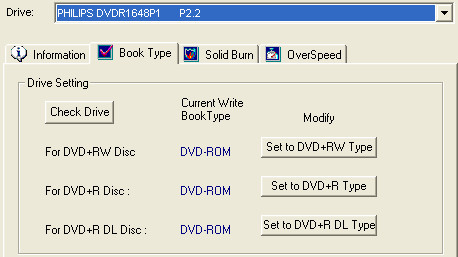

In Nero, you can set the drive to burn all plus format media as DVD-ROM booktype,
from the recorder's properties. This option is also set by default.
25. Conclusion
Philips is one of the greatest manufacturers in the optical storage industry.
So we expected this drive to be a certain success, and so it is. Beginning
from CD/DVD reading performance, the Philips DVDR1648P appears to be one of
the fastest drives on the market. The CD reading speed of 48X was not only
confirmed but the drive also reached 50X. With DVD, the 12X supported reading
speed for all DVD±R/RW media is rather good, and makes the drive faster
than many other popular drives. When it comes to DVD-Video ripping, you'll
find that you won't need an extra DVD-ROM reader since the Philips is certainly
faster than any other.
You might think that sometimes it is much safer to read at a lower speed.
While this might be correct in most cases, it is highly dependent on the drive's
error correction ability. The DVDR1648P, as our tests showed, has a very strong
CD and DVD error correction mechanism, so there will be no problem even at
high reading speeds.

The Philips drive managed to obtain a perfect score of 100 in the CDSpeed
DAE quality test, while its reading performance with AudioCDs is rather good.
Note that the 48X CAV DAE speed supported by the Philips drive, which is the
fastest available speed on the market today, is something that not many drives
support. Our 99min Audio test disc was not a problem for the DVDR1648P but
on the other hand, the 90min was. The drive failed to finish the test.
Protection schemes, especially for AudioCDs, are not a problem for the Philips
drive which will play/rip any Key2Audio or CDS200 protected AudioCD. But when
it comes to game protections, the scene changes. The drive reported average
performance, managing to create working backups of Safedisc protection only
up to version 2.8. So, if you are planning to get a drive to backup your protected
games, we recommend you try a CD burner instead.
The Philips burner supports 48X CD writing speed, which is high, but too fast
for quality results. So, it is better, if you want to make high quality CD
backups, to use quality media and choose a speed lower than 48X. Our quality
scans reported that the DVDR1648P is a good CD burner but at 48X, a little
improvement won't go astray :-)
The supported recording speeds for the DVD formats are the highest available
on the market. 16X for DVD±R/R, 8X for DVD+RW, 6X for DVD-RW, 8X for
DVD+R DL and 4X DVD-R DL. According to our tests the drive has a large 16X
media compatibility list, while it managed to overburn with both DVD+R and
DVD-R media under CDSpeed but not with Nero Burning Rom, so there are some questions about this. The reported overall quality of the Philips was very good with
rather low PIE error levels and smooth reading graphs in CDSpeed. With some
specific media, the quality was not excellent, but better than average while
this is also something which can be improved with a future firmware revision.
SolidBurn technology is claimed to guarantee high quality burns but there
are some questions about whether the feature actually works or not. Enabling
the SolidBurn feature did not make any difference in our tests. The possible
reasons for this behavior are either the poor implementation of the SolidBurn
in the Nero Beta software, or the premature version of the SolidBurn technology
itself.
We expect Philips to further improve the SolidBurn feature. In addition, it
would be reasonable to include a SolidBurn test function that would just test
the media without actually recording data on it. This could allow users to
decide whether they should use the function according to their media.
Booktype setting is something that Philips has supported from the outset. With
the contribution of several utilities, such as DVDinfoPro or CDSpeed, you'll
be able to change the booktype on all plus format media. With CDSpeed or DVDinfoPro,
you can also measure writing quality on media, something we don't recommend
however since the actual speed, as it was reported in our tests, was lower
than 1X, unless you are extremely patient :-)
So, if you need a good drive in all tasks, we believe the the DVDR1648P to
be one of your options...
- The Good
- Can burn DVD+RW media at 8X, and DVD-RW media at 6X
- DVD-R DL support at 4x, and DVD+R DL support at 8x
- Very good CD and DVD error correction capabilities
- Supports CD-Text (reading/writing)
- Supports audio protected discs
- Very Good DVD±R writing quality
- Can overburn up to 99min CDs
- Can overburn on DVD media
Fast DVD-Video ripping speed
- Fast DAE speed
Large DVD compatibility list for 16X recordings
- Supports Bitsetting for DVD+R, DVD+RW and DVD+R DL
- The Bad
- Mount Rainier is not supported
- Cannot create working backups with SafeDisc protected games over v2.90
- No overspeed
- The actual reading speed was very slow when measuring writing quality
on DVD media
- Like To be fixed
- Some doubts about SolidBurn Technology
- There are some questions if the drive can actual overburn on DVD media
| Retail Package |
 |
| Reading |
 |
| Error Correction |
 |
| Protected Discs |
 |
| Writing |
 |
| Features |
 |